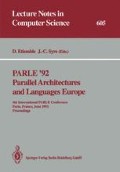Abstract
A major goal in designing multicomputer networks is to include fault-tolerance capability so that the system can continue to operate correctly after losing some of its basic components. This is normally achieved by introducing redundancy, that is, by including spare nodes (processors) and extra edges (links). It is desirable that these extra nodes and edges be minimized to reduce the cost of tolerating failure. This approach, however, tend to distribute the edges unevenly over the nodes. Thus, it can lead to solutions with maximal fanout, which may not be acceptable in practice. In this paper, we propose an alternate approach in which minimizing fanout has higher priority over minimizing edges. We apply this approach to the problem of constructing k-fault-tolerant (k-ft) extensions of complete bipartite networks, where k is the number of nodes failure to be tolerated. For arbitrary values of k, our results indicate that finding a fanout-optimal solution is very difficult, and might require an exponential search. The algorithm proposed for finding such an optimal solution, for any k, is useful only when the size of the network is not very large. For small values of k, (e.g., k=1), we show that an optimal solution can be constructed in polynomial time.
This work has been partially supported by NSERC-Canada.
Preview
Unable to display preview. Download preview PDF.
References
M. Alam and R. Melhem, “An Efficient Modular Allocation Scheme and Its Applications to Fault Tolerant Binary Hypercubes”, IEEE Trans. Parallel and Distributed Sys., V. 2 N. 1, Jan 1991, pp. 117–125.
T. Anderson and P. Lee, “Fault Tolerance-Principles and Practice,” Prentice-Hall International, London 1981.
S. Dutt and J. Hayes, “Design and Reconfiguration Strategies for Near-Optimal k-ft Tree Architectures” Proc. 18th Fault-Tolerant Comp. Symp., Tokyo, Japan, June 1988.
A. Farrag and R. J. Dawson, “Designing Optimal Fault-Tolerant Star Networks,” in Networks, Vol. 19, N. 6, Oct 1989, pp. 707–716.
A. Farrag and R. J. Dawson, “Fault-Tolerant Extensions of Complete Multipartite Networks,” in Proc. IEEE Conf. on Dist. Computing Systems, June 1989, pp. 143–150.
A. Hassan and V. Agrawal, “A Modular Approach to Fault-Tolerant Modular Tree Architecture,” Proc. 15th Fault Tolerant Comput. Symp., June 1985, pp. 344–349.
J. Hayes, “A Graph Model for Fault-Tolerant Computing Systems,” IEEE Trans. on Computers, V. c-25, N. 9, September 1976, pp. 875–884.
L. Hua, “Introduction to Number Theory,” Springer-Verlag, New York, 1982.
R. Keller, G. Lindstorm, and S. Patil, “A Loosely coupled Applicative Multiprocessing System,” in AFIPS Proc. of the National Computer Conf., 1979, pp. 613–622.
C. Kwan and S. Toida, “An Optimal 2-FT Realization of Binary Symmetric Tree Systems,” in Networks, V. 12, 1982, pp. 231–239.
M. Lowrie and W. Fuchs, “Reconfigurable Tree Architectures Using Subtree Oriented Fault Tolerance,” IEEE Trans. on Computer, October 1987, pp. 1172–1182.
G. Myers, “Advances in Computer Architecture,” John-Wiley & Sons, New York, 1982.
C. Raghavendra, A. Avizienis and M. Ercegovac, “Fault-Tolerant in Binary Tree Architectures,” IEEE Trans. on Computers, V. c-33, N. 6, June 1984, pp. 568–572.
E. Schmitter and P. Baues, “The Basic Fault-Tolerant System,” IEEE Micro, V. 4, N. 1, February 1984, pp. 66–74.
Author information
Authors and Affiliations
Editor information
Rights and permissions
Copyright information
© 1992 Springer-Verlag Berlin Heidelberg
About this paper
Cite this paper
Farrag, A.A., Dawson, R., Yao, Q. (1992). On designing fault-tolerant extensions with optimal fanout for complete bipartite networks. In: Etiemble, D., Syre, JC. (eds) PARLE '92 Parallel Architectures and Languages Europe. PARLE 1992. Lecture Notes in Computer Science, vol 605. Springer, Berlin, Heidelberg. https://doi.org/10.1007/3-540-55599-4_88
Download citation
DOI: https://doi.org/10.1007/3-540-55599-4_88
Published:
Publisher Name: Springer, Berlin, Heidelberg
Print ISBN: 978-3-540-55599-5
Online ISBN: 978-3-540-47250-6
eBook Packages: Springer Book Archive

